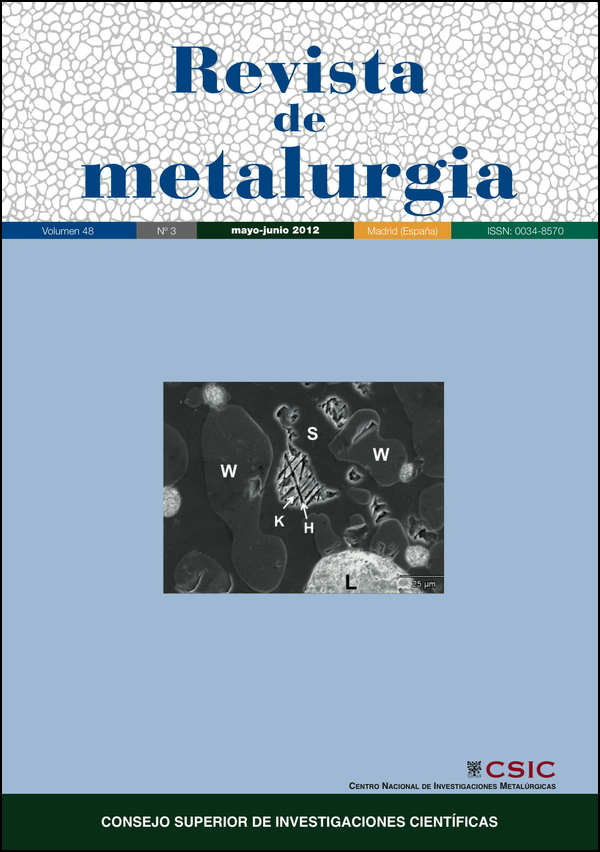Distribution of lead and silver under lead blast furnace conditions
DOI:
https://doi.org/10.3989/revmetalm.1150Keywords:
Slag, Lead, Silver, Lead blast furnace, SolubilityAbstract
Two experimental studies of metal solubility in slags were carried out at 1473 K (1200 °C). In the first one the solubility of lead in the PbO-ZnO-CaO-SiO2-“Fe2O3” slag system under a reducing atmosphere (PCO/PCO2 = 2.45) was studied. In the second part, slags of the CaO-SiO2-“Fe2O3” system were equilibrated with Pb - 1.3 mass % Ag alloys under an inert atmosphere. In both cases the CaO/SiO2 mass ratio was from 1.0 to 1.6 and Fe/SiO2 mass ratio was 1.1 and 1.7. The lead solubility in the slags of both experimental parts diminishes with increasing the slag basicity (CaO/SiO2) and diminishing the Fe/SiO2 ratio. Lead oxide is the only compound that can be reduced under the reducing atmosphere and at the temperature at the tuyeres level, 1473 K. Silver solubility in slags decreases with increasing both CaO/SiO2 and Fe/SiO2 ratios in the slags of the CaO-SiO2-“Fe2O3” system.
Downloads
References
[1] P. C. Hayes, M. E. Schlesinger, H-U. Steil and A. Siegmund, Lead-Zinc 2010 Conference, Vancouver, Canada (ed: A. Siegmund, L. Centomo, C. Geenen, N. Piret, G. Richards and R. Stephens) (TMS) 2010, pp. 345-355.
[2] J. Sancho, L. F. Verdeja and A. Ballester, Metalurgia Extractiva: Procesos de Obtención. Ed. Síntesis, Madrid, España, 2000, pp. 377-404.
[3] A. Ballester, L. F. Verdeja and J. Sancho, Metalurgia Extractiva: Fundamentos. Ed. Síntesis, Madrid, España, 2000, pp. 267-284.
[4] E. Jak and P. C. Hayes, Lead-Zinc 2010 Conference, Vancouver, Canada (ed: A. Siegmund, L. Centomo, C. Geenen, N. Piret, G. Richards and R. Stephens) (TMS) 2010, pp. 1161-1176.
[5] P. Tan and P. A. Vix, EPD Congress 2005, San Francisco, California, USA (ed: M. Schlesinger) (TMS) 2005, pp. 329-338.
[6] F. A. Calvo and A. Ballester, Metall. Mater. Trans. B, 17B (1986) 267-270.
[7] M. E. Schlesinger and D. C. Lynch, Metall. Mater. Trans. B, 17B (1986) 817-827.
[8] M. Kudo, E. Jak, P. Hayes, K. Yagamuchi and Y. Takeda, Metall. Mater. Trans. B, 31B (2000) 15-24. http://dx.doi.org/10.1007/s11663-000-0126-8
[9] H. M. Henao, P. C. Hayes, E. Jak and G. G. Richards, Lead-Zinc 2010 Conference, Vancouver, Canada (Eds: A. Siegmund, L. Centomo, C. Geenen, N. Piret, G. Richards and R. Stephens) 2010, pp. 1145-1160.
[10] D. R. Morris, B. R. Amero, P. G. Evans, W. Petruk and D. R. Owens, Metall. Mater. Trans. B, 14B (1983) 617-623.
[11] J. T. Chao, P. J. Dugdale, D. R. Morris and F. R. Steward,Metall. Mater. Trans. B, 9B(1978) 293-300.
[12] W. T. Thompson, C. W. Bale and A. D. Pelton, Facility for the Analysis of Chemical Thermodynamics (FACTSage), Ecole Polytechnique, Montreal, 2011, http:www.crct.polymtl.ca.
[13] A. Romero-Serrano and A. D. Pelton, Metall. Mater. Trans. B, 26B (1995) 305-315. http://dx.doi.org/10.1007/BF02660973
Downloads
Published
How to Cite
Issue
Section
License
Copyright (c) 2012 Consejo Superior de Investigaciones Científicas (CSIC)

This work is licensed under a Creative Commons Attribution 4.0 International License.
© CSIC. Manuscripts published in both the printed and online versions of this Journal are the property of Consejo Superior de Investigaciones Científicas, and quoting this source is a requirement for any partial or full reproduction.
All contents of this electronic edition, except where otherwise noted, are distributed under a “Creative Commons Attribution 4.0 International” (CC BY 4.0) License. You may read the basic information and the legal text of the license. The indication of the CC BY 4.0 License must be expressly stated in this way when necessary.
Self-archiving in repositories, personal webpages or similar, of any version other than the published by the Editor, is not allowed.
















